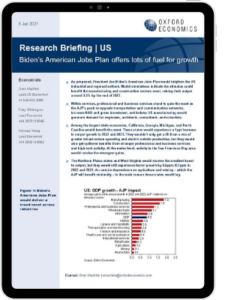Research Briefing
| Jun 10, 2021
US | Biden’s American Jobs Plan offers lots of fuel for growth

As proposed, President Joe Biden’s American Jobs Plan would brighten the US industrial and regional outlook. Model simulations indicate the stimulus could benefit the manufacturing and construction sectors most, raising their output around 3.5% by the end of 2023.
What you will learn:
- Our modeling indicates that the proposed American Jobs Plan (AJP) would deliver the greatest boost to the manufacturing industry, propelling faster growth by about 1.8ppts on average in 2022 and 2023. This stimulus would also create an additional 290k manufacturing jobs by year-end 2023 relative to a no-stimulus scenario.
- The AJP would also strengthen services, most significantly professional and business services. Activity in the professional and business services industry would grow 1.3ppts faster on average in 2022 and 2023.
- Among the largest state economies, California, Georgia, Michigan, and North Carolina would benefit the most. These states would experience a 1ppt increase in output growth in 2022 and 2023. At the metro level, activity in the San Francisco Bay area would receive the strongest gains.
Tags:
Related Services

Post
US Key Themes 2026: Exceptionalism amid fragmentation
US exceptionalism is alive and well, and that won't change in 2026.
Find Out More
Post
Global Key themes 2026: Bullish on US despite AI bubble fears
We anticipate another year of broadly steady and unexceptional global GDP growth, but with some more interesting stories running below the surface.
Find Out More[autopilot_shortcode]
